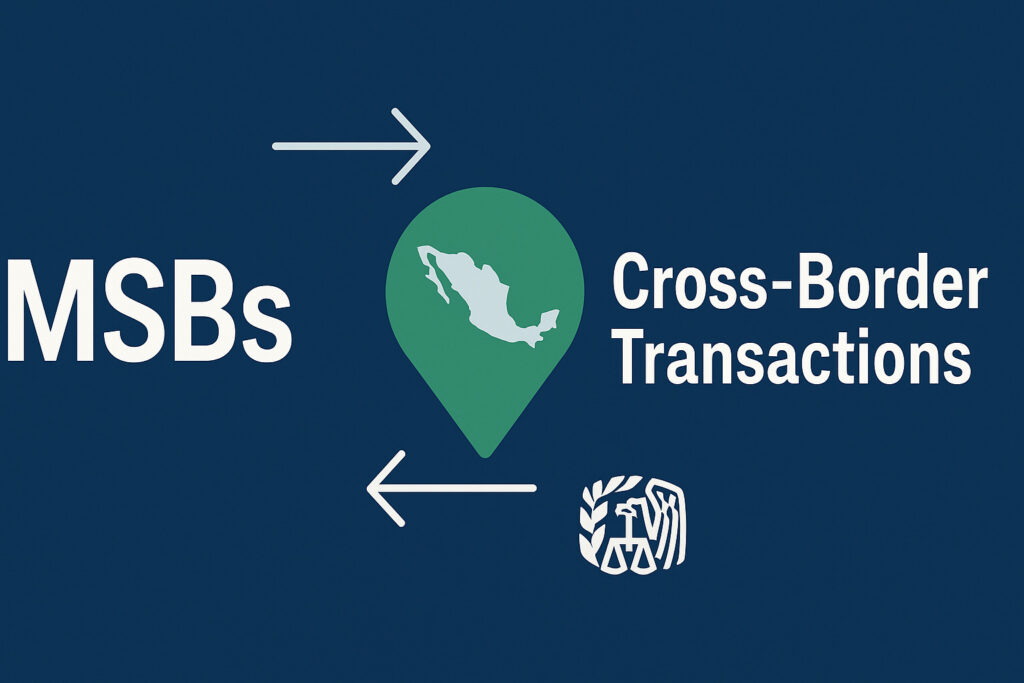Introduction
Cross-border payments between the United States and Mexico represent one of the largest remittance corridors in the world. Millions of individuals and businesses rely on these transfers to send money for family support, trade, and investment. According to the Bank of Mexico, remittances into Mexico reached over $63 billion in 2024, making the country the second largest recipient of remittances globally, after India.
Traditionally, large players like Western Union, MoneyGram, and major banks have dominated this market. However, the growing demand for faster, cheaper, and more accessible services has opened the door for new Money Services Businesses (MSBs) to enter and innovate. With the right licensing, compliance, and operational structure, MSBs can play a central role in improving the efficiency and affordability of U.S.–Mexico cross-border payments.
How Cross-Border Payments Work Through MSBs
MSBs function as regulated intermediaries that facilitate the transfer of money domestically and internationally. In the case of U.S.–Mexico payments, the process typically involves:
1. Customer Onboarding – A sender in the U.S. provides funds to the MSB via cash, card, bank account, or digital wallet. The MSB verifies the customer’s identity using KYC and AML procedures.
2. Funds Transmission – The MSB pools payments and transmits funds through partner institutions, correspondent banks, or directly through settlement accounts in Mexico. Settlement may occur via bank wires, international ACH, or local payout networks.
3. Recipient Access – The recipient in Mexico receives the funds through a bank account deposit, cash pick-up location, or direct wallet transfer. Modern MSBs often integrate with fintech wallets and card issuers for instant access.
Licensing and Regulatory Requirements
In the United States:
– Federal Registration: All MSBs must register with FinCEN and comply with the Bank Secrecy Act (BSA).
– State Licensing: Each U.S. state where the MSB operates requires a separate license, unless under MTMA.
– Surety Bonds & Capital: States typically require surety bonds and net worth based on transaction volume.
In Mexico:
– Regulation by CNBV: The Comisión Nacional Bancaria y de Valores regulates financial institutions, including transmitters.
– SPEI Access: MSBs often need partnerships with Mexican banks or fintechs to access SPEI, the real-time payments system.
– Local Licensing: Some MSBs partner with SOFOM ENRs or other institutions to facilitate payouts and compliance.
The Size of the Industry
The U.S.–Mexico remittance corridor is not just large — it is growing:
– In 2024, total remittances into Mexico exceeded $63 billion, nearly 4% of Mexico’s GDP.
– Approximately 95% of these flows come from the U.S.
– Remittances are a critical source of income for millions of Mexican households, funding essentials like housing, education, and small businesses.
Despite the scale, consolidation among a few players has limited innovation. Fees remain high, particularly in rural areas or among the unbanked.
Why More MSBs Are Needed
The demand for cross-border payment solutions continues to outpace the available infrastructure. More MSBs are needed to:
1. Increase Competition – More licensed operators drive down costs and improve services.
2. Expand Access – MSBs can partner with local outlets, banks, and fintechs to reach underserved areas.
3. Integrate Technology – Blockchain, wallets, and real-time rails reduce costs and increase speed.
4. Support Small Businesses – Provide low-cost payment solutions for U.S. SMEs and Mexican suppliers.
5. Strengthen Compliance – Smaller, modern MSBs can reduce laundering and fraud risks.
Conclusion
The U.S.–Mexico remittance corridor is one of the largest in the world, and its importance to households, businesses, and the broader economy cannot be overstated. While the market has long been dominated by a few large firms, the industry is ripe for disruption.
New MSBs, built with strong compliance, modern technology, and efficient cross-border partnerships, can bring down costs, expand access, and improve financial inclusion. As remittances continue to grow, the demand for innovative and customer-friendly MSBs will only increase.
For entrepreneurs, investors, and financial institutions, building an MSB focused on U.S.–Mexico cross-border payments is not just a regulatory challenge — it is a major business opportunity.

